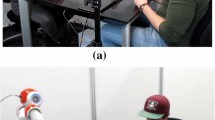Abstract
Currently there exists literature and research done on the role of personality in robots. However the existing research involves exhibiting personality on some platform which contains human cues. On the other hand, there exists little research on attempts to synthesize and exhibit personality without the use of any humanoid cues. In our research, we explore this challenge. In concrete, we define four parameters that modulate the migration behavior (motion path and schedule) of an information-seeking agent in a virtual 2D environment where only moving triangles and static rectangles reside. The presented model will be applicable to any mobile social robots. We setup five different agent behaviors as video stimuli and asked subjects to evaluate the agent’s personality based on the Big Five personality traits model. The results suggest that people perceive different personalities from different parameter settings. We will discuss the future direction and issues based on the results.
This work is supported by Honda Research Institute Japan Co., Ltd.
Access this chapter
Tax calculation will be finalised at checkout
Purchases are for personal use only
Similar content being viewed by others
Notes
- 1.
The six videos are accessible with the following URL: https://drive.google.com/open?id=1eLNT7Bv7k1ETtRD1o3LqTaZDHRLxRhqW.
- 2.
- 3.
These questions were (A) whether the worker is confident in the understanding of the instruction; (B) the direction of the red triangle’s final movement in the first video; (C) the color of an entity that the red triangle knows very well; and (D) the target of the second questionnaire (self or other).
References
Aylett, M.P., Vinciarelli, A., Wester, M.: Speech synthesis for the generation of artificial personality. IEEE Trans. Affect. Comput. (2017). (early access)
Bohane, L., Maguire, N., Richardson, T.: Resilients, overcontrollers and undercontrollers: a systematic review of the utility of a personality typology method in understanding adult mental health problems. Clin. Psychol. Rev. 57, 75–92 (2017)
Dautenhahn, K.: Roles and functions of robots in human society: implications from research in autism therapy. Robotica 21, 443–452 (2003)
Gosling, S.D., Rentfrow, P.J., Swann Jr., W.B.: A very brief measure of the big five personality domains. J. Res. Pers. 37, 504–528 (2003)
Gosling, S.D., Sandy, C.J., Potter, J.: Personalities of self-identified “dog people” and “cat people”. Anthrozoös 23(3), 213–222 (2010)
Heider, F., Simmel, M.: An experimental study of apparent behavior. Am. J. Psychol. 57, 243–259 (1944)
Hu, X., Xie, L., Liu, X., Wang, Z.: Emotion expression of robot with personality. Math. Prob. Eng. 2013(132735), 1–10 (2013)
John, O.P., Srivastava, S.: The Big Five trait taxonomy: history, measurement, and theoretical perspectives. In: Pervin, L.A., John, O.P. (eds.) Handbook of Personality: Theory and Research, pp. 102–138. Guilford Press, New York (1999)
Koppensteiner, M.: Perceiving personality in simple motion cues. J. Res. Pers. 45, 358–363 (2011)
Lakatos, G., Gácsi, M., Konok, V., Brúder, I., Bereczky, B., Korondi, P.: Emotion attribution to a non-humanoid robot in different social situations. PLoS ONE 9(12), e0121929 (2014)
Lee, K.M., Peng, W., Jin, S.A., Yan, C.: Can robots manifest personality? An empirical test of personality recognition, social responses, and social presence in human–robot interaction. J. Commun. 56(4), 754–772 (2006)
McRorie, M., Sneddon, I., McKeown, G., Bevacqua, E., de Sevin, E., Pelachaud, C.: Evaluation of four designed virtual agent personalities. IEEE Trans. Affect. Comput. 3(3), 311–322 (2012)
Miwa, H., Takanishi, A., Takanobu, H.: Experimental study on robot personality for humanoid head robot. In: International Conference on Intelligent Robots and Systems, pp. 1183–1188 (2001)
Oshio, A., Abe, S., Cutrone, P.: Development, reliability, and validity of the Japanese version of ten item personality inventory (TIPI-J). Jpn. J. Pers. 21(1), 40–52 (2012)
Robins, R.W., John, O.P., Caspi, A., Moffitt, T.E., Stouthamer-Loeber, M.: Resilient, overcontrolled, and undercontrolled boys: three replicable personality types. J. Pers. Soc. Psychol. 70(1), 157–171 (1996)
Sequeira, J.S.: Can social robots make societies more human? Information 9, 295 (2018)
Tapus, A., Tapus, C., Mataric, M.: User-robot personality matching and robot behavior adaptation for post-stroke rehabilitation therapy. Intell. Serv. Robot. 1(2), 169–183 (2008)
Vinciarelli, A.: A survey of personality computing. IEEE Trans. Affect. Comput. 5(3), 273–291 (2014)
Author information
Authors and Affiliations
Corresponding author
Editor information
Editors and Affiliations
Rights and permissions
Copyright information
© 2019 Springer Nature Switzerland AG
About this paper
Cite this paper
Lee, S., Funakoshi, K., Iwai, R., Kumada, T. (2019). Personality Synthesis Using Non-humanoid Cues. In: Salichs, M., et al. Social Robotics. ICSR 2019. Lecture Notes in Computer Science(), vol 11876. Springer, Cham. https://doi.org/10.1007/978-3-030-35888-4_21
Download citation
DOI: https://doi.org/10.1007/978-3-030-35888-4_21
Published:
Publisher Name: Springer, Cham
Print ISBN: 978-3-030-35887-7
Online ISBN: 978-3-030-35888-4
eBook Packages: Computer ScienceComputer Science (R0)




